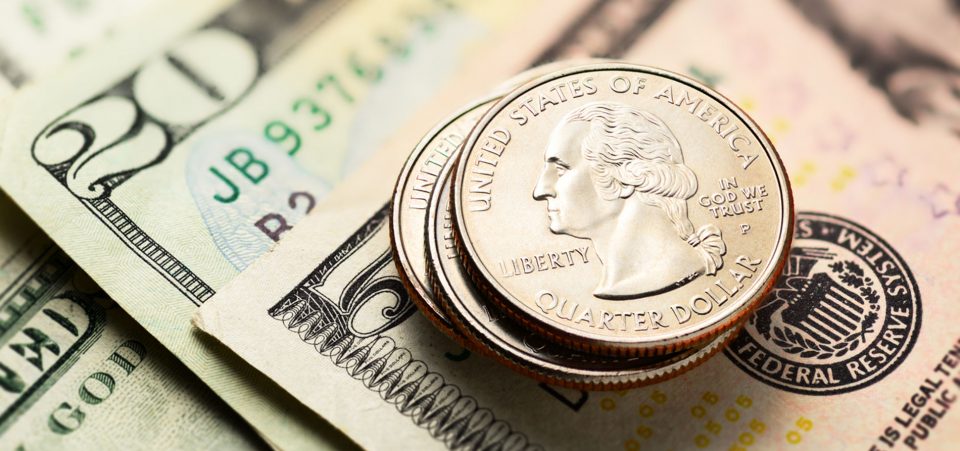This Could Trigger a U.S. Dollar Collapse in 2017
The American economy has a lot of momentum, but the unhinged trade policies of President Donald Trump could trigger a U.S. dollar collapse in 2017.
At first blush, the dollar seems to enjoy a lot of momentum. Renewed growth prospects emanating from Trumpian policies and higher interest rate expectations have provided a constant bid, buoying the U.S. Dollar Index to 14-year highs in early January. It’s been on a different trajectory since then, though, having lost more than eight percent of its value.
Perhaps the collapse of the U.S. dollar is beginning.
While Trump remains optimistic about the U.S. economy, the fact is a U.S. dollar collapse in 2017 could be imminent, depending on the free trade policy agenda of Donald J. Trump.
So why is the liberal international exchange of goods so paramount to the health of the U.S. dollar? One reason has to do with foreign demand of U.S. dollars.
When the U.S. exports goods, this creates demand for the dollar since foreign buyers must pay in U.S. dollars to acquire these goods. Foreign entities convert their own currencies to U.S. dollars to accomplish this, boosting demand for the Greenback. It’s the basic concept of supply and demand written about by Adam Smith in his 1776 book, The Wealth of Nations.
A similar dynamic occurs when America runs up large trade deficits from the importation of goods, except in reverse. As U.S. dollar outflows make their way off continent, foreign governments who acquire them build up foreign reserve treasure chests. They then look to recycle these dollars back into America, whether voluntary or implicit, through the purchase of newly-issued U.S. Treasuries and corporate debt. As these financial instruments are purchased in U.S. dollars, this creates a constant continuum of demand.
As the United States issues the world’s reserve currency and is its undisputed military kingpin, this creates a monopoly, and discipline is needed to keep this whole system together. Historically, it hasn’t ended well for leaders attempting to break free from this construct, which is probably why it’s worked so well for so long.
Deteriorating Political Relations Signaling Trouble Ahead?
The U.S. dollar forecast for 2017 has a high state of variance owing to the Machiavellian nature of Trump’s views of trade. These views are constantly in the news cycle, ranging from the reckless to outrageous; from Trump threatening to tax BMW imports to threatening to withdraw from the North American Free Trade Agreement (NAFTA) or the imposition of punitive tariffs on China. He is on record calling the World Trade Organization (WTO) a “disaster.” (Source: “Trump’s Trade Plan Is a Looming Disaster,” Bloomberg, January 17, 2017.)
The list goes on, and there’s little doubt the rhetoric is beyond posturing.
There are also threats that are less implicit, but nonetheless as concerning from the macro perspective of global security. As an obvious correlation exists between political friction and buoyant trade between nations, the negative relations we’ve witnessed so far between America and its biggest trade partners bodes poorly.
Take, for instance, Trump accepting a call from Taiwanese President Tsai Ing-wen. Irrespective of the reasons behind it, it is believed to be the first direct call a U.S. president or president-elect has taken from a Taiwanese leader since ties were severed between the two nations in 1979. This is a huge deal to China, which considers this a direct challenge to its “One China” policy. The fact Trump would even go there is suggestive of the aggressive nature his foreign policy is likely to employ.
Further insight on the future tone of Sino-American relations was on full display during the Secretary of State Confirmation hearings. On the topic of China, Rex Tillerson said Beijing’s ongoing island-building strategy—through which $5.0 trillion of trade passes annually—was illegal and “akin to Russia’s taking of Crimea.” Tillerson further stated his intentions to halt reef island construction and vowed that China’s “access to those islands also is not going to be allowed.” (Source: “Chinese Media Has Told Rex Tillerson to ‘Prepare for a Military Clash,’” TIME, January 12, 2017.)
As the reference title states, the Chinese were not impressed.
With all the calamity, threats, and innuendo surrounding China-U.S. relations—relations which have steadily deteriorated even before Trump entered the picture—it seems assured trade between the two global titans will take a wrong turn. While Trump castigates the massive annual trade deficit with China, a steep reduction of trade could lead the Chinese to suspend U.S. debt purchases altogether, which is destabilizing to the dollar.
There’s also the risk that China—the world’s biggest foreign holder of U.S. government debt—dumps a significant portion of its $1.19 trillion portfolio, thereby weakening the dollar in a material way.
Trump must be careful what he wishes for.
Will the U.S. Dollar Collapse in 2017?
It doesn’t take much imagination how events taking place at this very moment could easily portend a U.S. dollar collapse. We previously illustrated how deteriorating relations with China could foreshadow worsening trade dynamics going forward, but in reality, this risk is interchangeable with all big U.S. trading partners. It doesn’t matter if this happens through border taxes or import tariffs, withdrawing from the WTO or embroiling itself in war—all these events lead to the same place for the U.S. dollar.
Beyond the U.S. dollar recycling continuum discussed above, there’s the simple fact that the U.S. economy will be materially weaker if protectionist tendencies rule the day. A weaker economy in conjunction with reduced dollar recycling would be a double whammy even king U.S. dollar might have trouble withstanding.
Currently, trade, defined as the sum of exports and imports of goods and services, is a huge slice of the economy. The latest World Bank figures (2015) have this pegged at over 28% of total U.S. GDP. (Source: “Trade (% of GDP),” The World Bank, last accessed July 24, 2017.)
In an economy with soaring debt levels and stall-speed growth, America can at least afford to shutter a major driver of economic growth—even if repatriating manufacturing domestically provides some offset. After all, the days of robust growth are probably behind us, and newly-built factories will be more automated and employ fewer people than before, blunting job creation benefits.
When Will the Dollar Collapse?
While it’s hard to give a definitive timeline, the best strategy to protect against the economic consequences of a dollar collapse lies with diversifying your portfolio in negative correlating assets.
Gold is one such asset, historically buffering currencies against falling values in local dollar terms. There are literally thousands of examples one could choose from, but we’ll highlight the recent performance of gold prices in British pounds as one such example.
As of this writing, one ounce of gold cost £959.11 to purchase, up from £956.00, post-Brexit. Meanwhile, the GPB/USD pair has fallen roughly 12% during that time. Put another way, had a Brit sold all their pounds for gold the day after the Brexit vote, over the ensuing months, they would have been significantly richer than by doing nothing at all.
Protecting wealth is what gold does, and will forever do.
Another asset worthy of consideration is Bitcoin, where controlled supply limits debasement otherwise seen in traditional currencies. The total number of bitcoins in circulation is currently 16.4 million, and it’s mathematically impossible for circulation to exceed 21 million as currently constructed. Its decentralized structure may also be attractive to those looking to store their wealth beyond the prying eyes of Uncle Sam.
Bitcoin doesn’t come without its share of risks, however. As it is not legal tender, the government may restrict transacting (or the exchanges which facilitate transactions) at any point. It also isn’t clear whether volatility will decrease to a level where mass mainstream adoption becomes tenable. However, signs are encouraging and investors would be wise to keep this asset on their radar screens.
Finally, non-risk adverse individuals might want to consider short selling stocks of companies affected by a falling USD, or selling USD currency futures contracts if perfect correlation to a U.S. dollar collapse is desired.
Fortunately, the question of how to protect yourself from a dollar collapse is a straightforward one. If the proper risk management principles are used, it’s possible to preserve wealth and thrive in these unprecedented times ahead.







